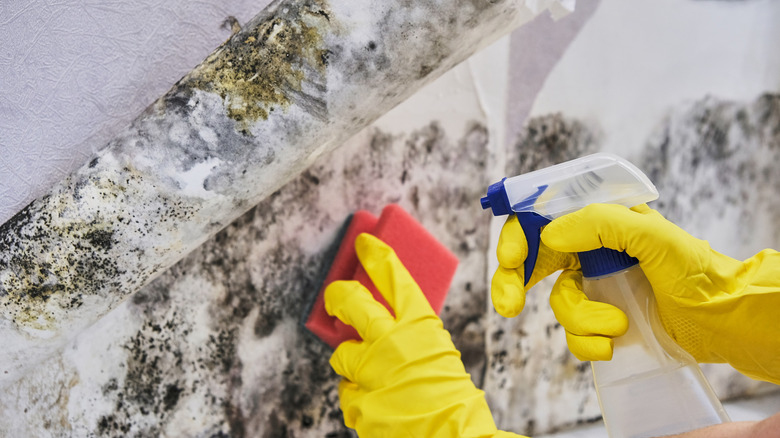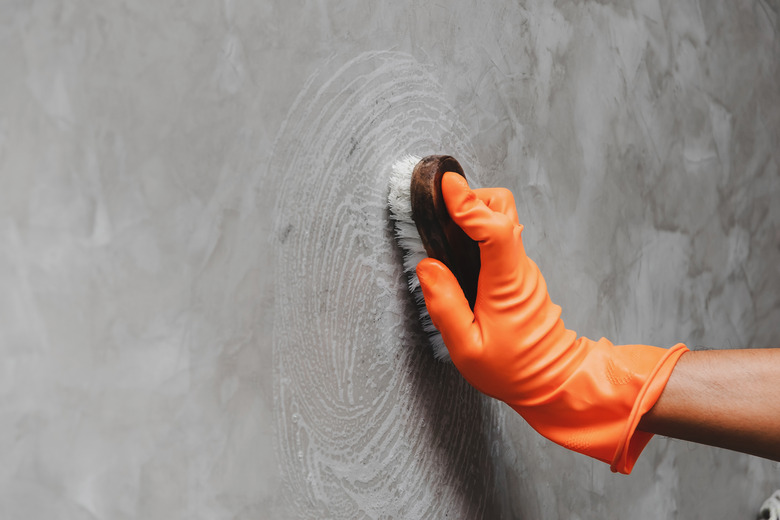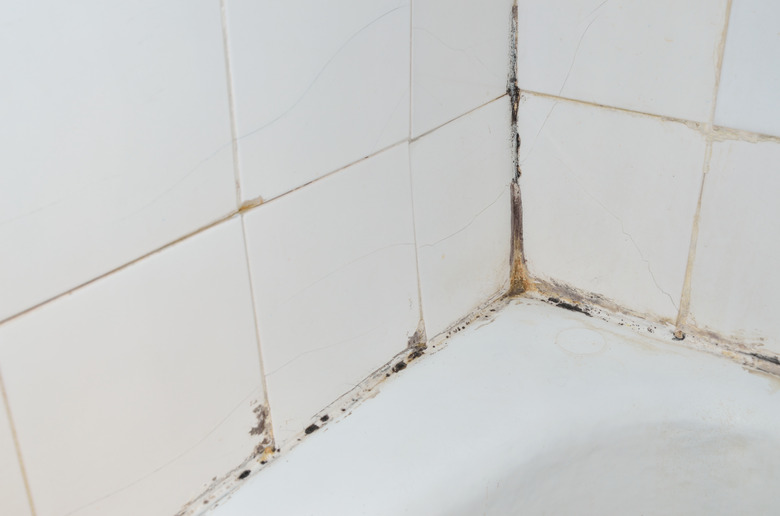How To Remove Mold In Every Area Of The House
We may receive a commission on purchases made from links.
Just the thought of mold removal can give us the willies, but spotting mold — any type of it — in the home triggers panic and a stream of questions. Do I need to hire someone for mold remediation? Can I just clean it up myself?
If you find a mold problem in your home, remain calm but act quickly. Chances are some DIY cleanup will get rid of the mold (and the subsequent mildew smell) and things will be fine. After that, it's all about moisture control — cleaning mold is pointless if you don't also take care of the water or dampness problem that caused it in the first place. To prevent further mold growth, you'll have to dry all damp furnishings, building materials and areas within 24 to 48 hours after first contact with water or after cleaning. Failure to include this in your approach will simply result in reappearance of the problem.
Dress for the Job
Dress for the Job
If Environmental Protection Agency (EPA) guidelines indicate that it's reasonable for you to do your own mold removal, you'll need to wear protective clothing and safety gear.
To avoid inhaling airborne mold and mold spores, wear a well-fitted respirator, whether it's the type with removable cartridges that block spore entrance or a NIOSH-certified N95 filtering-facepiece respirator that includes a nozzle. Protect your eyes from mold spores with nonvented safety goggles and wear protective rubber gloves that reach midforearm unless you're using extra-strength cleaning solutions, disinfectants or chlorine bleach. For this, gloves made from neoprene, polyurethane, PVC, natural rubber or nitrile are best. If there's standing water after a flood, don waterproof boots. Finally, deal with potential bleach splatters by digging out your nastiest old clothes — some you won't mind tossing afterward.
Gather Your Supplies
Gather Your Supplies
If your mold cleanup isn't in response to flood damage but is confined to a smaller area or spot in your house, just some basic cleaning supplies should do it. You'll need the following:
- Bucket
- Stiff-bristle brush
- Paper towels
- Household bleach, distilled white vinegar, 3-percent hydrogen peroxide or borax
- Nonphosphate dish detergent
- Old cloths
Mold cleanup after more extensive damage, such as a flood, calls for these additional supplies:
Know Your Cleaning Products
Know Your Cleaning Products
We often think of bleach in regard to mold removal, but instead of routinely recommending bleach, the EPA often advises simply wiping mold with water and mild detergent. Several other more natural and less harsh products are also effective against mold, so it's a good idea to get informed before you choose.
If you use household bleach for cleaning mold, here are some things to keep in mind:
- Regular household bleach should be mixed 1 cup to 1 gallon of water and applied with a spray bottle or sponge.
- Bleach kills nearly any type of mold it meets. Because it creates an environment on the surface that's resistant to future mold growth, rinse after use only if it's a surface used for food preparation or something children might handle.
- Perhaps the most important thing to keep in mind when using bleach is
that you should never mix bleach solution with other household cleaners, especially
ammonia, hydrogen peroxide or acids, such as vinegar.
Not wanting to use bleach? There are many other types of strong cleaning products that can still knock mold out of any surface.
- An undiluted 3 percent solution of hydrogen peroxide can be sprayed, allowed to stand for several minutes and then wiped. Just keep in mind that because peroxide can take the color out of fabrics and other materials, you should test a spot first.
- Borax can be mixed 1 cup to 1 gallon of water. Before use, vacuum any loose mold using a vacuum cleaner with a HEPA filter. Scrub with a brush to clean the mold and do not rinse. Wipe up excess to prevent it from spreading as it dries.
- Undiluted white distilled vinegar should be sprayed on the moldy surface and left for one hour. Wipe clean with water and let it dry.
- Nonphosphate dish detergent mixes with water to make a nontoxic, soapy solution for wiping and scrubbing mold, and it's not as harsh as bleach.
How to Remove Mold From Household Surfaces
How to Remove Mold From Household Surfaces
The EPA recommends that homeowners handle mold removal only when water damage is from clean water (not sewer backup or contaminated water) and when there is less than 10 square feet of actual mold present. Ultimately, the choice is yours.
1. Remove the Mold-Infested Debris
Unless you've chosen to handle massive flood damage on your own and are dealing with preliminary debris removal and mud scooping, you'll begin by carrying out water-damaged, mold-infested items in sealed plastic bags that will prevent the spread of mold spores. Any items that are too large for resealable bags should be wrapped with polyethylene sheeting and sealed with duct tape before removal.
2. Discard Mold-Infested Porous Materials
Next, identify and discard any mold-infested porous materials in the affected area. These include carpets, rugs, wallpaper, drywall and acoustical ceiling tiles. Mold infiltrates such substances, growing on and filling crevices and empty spaces. You won't be able to clean the mold out of such items, so clear them out of the way.
3. Scrub All Surfaces
Now, the elbow-grease phase of your cleaning begins. Scrub all hard surfaces, such as flooring, tile, stone, countertops, sinks, molding and furniture (both wood and metal), with water and dish detergent. Scrub more stubborn mold stains with a stiff-bristle brush and bleach solution.
4. Dry Thoroughly
Begin drying surfaces immediately after cleaning and dry thoroughly using fans, dehumidifiers and air conditioners when possible. The aim is to achieve a complete drying within 48 hours to prevent recurrence of mold. Although it's always safer to dry wood with only fans and dehumidifiers, it's also important to dry within 48 hours to prevent mold growth, which will necessitate the use of space heaters. Just be sure you place these on a low setting.
Cleaning Mold From Different Items and Surfaces
Cleaning Mold From Different Items and Surfaces
Although the basic principles of cleaning mold from household surfaces are roughly the same, different materials may require extra special care so that you don't damage them.
References
- United States Environmental Protection Agency: A Brief Guide to Mold, Moisture and Your Home
- Centers for Disease Control and Prevention: The National Personal Protective Laboratory Certified Equipment List: Approval #1299 3M Model 8511
- Centers for Disease Control and Prevention: Shopping List for Cleaning Mold in Your Home After a Flood
- Utah Department of Health: Common Cleaning Products Can Be Dangerous When Mixed
- Purdue University Extension: Using Hydrogen Peroxide for Sanitizing and Disinfecting
- Mississippi State University Extension: Safety Tips: Combating Black Mold
- Centers for Disease Control and Prevention: You Can Control Mold
- North Carolina State Extension: Removing Mold From Household Items
- United States Environmental Protection Agency: Mold Course Chapter 4: General Remediation Issues
- Centers for Disease Control and Prevention: Mold Cleanup After Disasters: When to Use Bleach
- United States Environmental Protection Agency: Should I Use Bleach To Clean Up Mold?
- National Environmental Education Foundation: Why Phosphate Free?
- Water Mold Fire Restoration: Porous vs. Non-Porous Materials
- Restoration Local: How To Dry Water Damaged Furniture
Hard-Surface Floors (Wood, Laminate, Linoleum, Tile, Vinyl)
Vacuum surface mold with a HEPA vacuum or mop with water and mild nonphosphate dish detergent (bleach does not penetrate wood to kill mold). Before attempting to remove the finish from your flooring, identify the type of finish and whether it's actually safe to strip it. Dry quickly and completely.
Rugs, Carpeting and Padding
To avoid mold, wet carpets and pads must be taken up and dried thoroughly within 48 hours of getting wet. Otherwise, discard them. Use a water extraction vacuum followed by fans, dehumidifiers, air conditioners or heaters. Clean moldy areas with a sponge and a carpet cleaning product or have it professionally shampooed. Apply hydrogen peroxide to stubborn mold stains after testing for colorfastness. If unsuccessful, toss the carpet.
Ceiling Tiles
Normally, you will discard them. If the mold growth is minimal, try cleaning with a damp cloth using a solution of water and mild nonphosphate detergent. Dry them quickly.
Drywall and Wallboards
These can be dried in place if there's no apparent swelling and if seams are intact. Thoroughly dry within 48 hours and discard any wet insulation. Use a HEPA vacuum and wipe them down with nonphosphate detergent. If drywall and wallboard is left in place to dry, take steps to ventilate the wall cavity.Hard-surface furniture: Wipe off visible mold with a damp rag and a solution of water and nonphosphate detergent. If sewage water was involved, use a bleach and water solution. Dry items thoroughly, keeping them out of direct sunlight to prevent warping.
Upholstered Furniture
Try to salvage by reupholstering only if sentimental value is involved or if it was in contact with clean water only briefly. Even minimal mold damage can be impossible to remove from such items.
Leather Furniture
Brush off mold spores with a clean cloth and then wipe with a solution of water and nonphosphate detergent. Wipe off any soapy residue, dry completely and then apply a leather conditioner. Leather items can also be wiped down using a 50/50 mixture of water and isopropyl alcohol before drying and applying conditioner.
Curtains and Draperies
If washable, pretreat mold stains using a detergent containing no ammonia. Wash in the hottest water allowed by the fabric label instructions. Use oxygen-based bleach for colors and delicates and chlorine bleach for colorfast, bleach-safe items.
Concrete Floors
Use a HEPA vacuum or, if water is present, a wet/dry vacuum. Scrub the area with a bleach or vinegar solution, rinse and after cleaning the nozzle on the wet/dry vacuum, use it again to remove rinse water. Use fans and dehumidifiers to dry.


